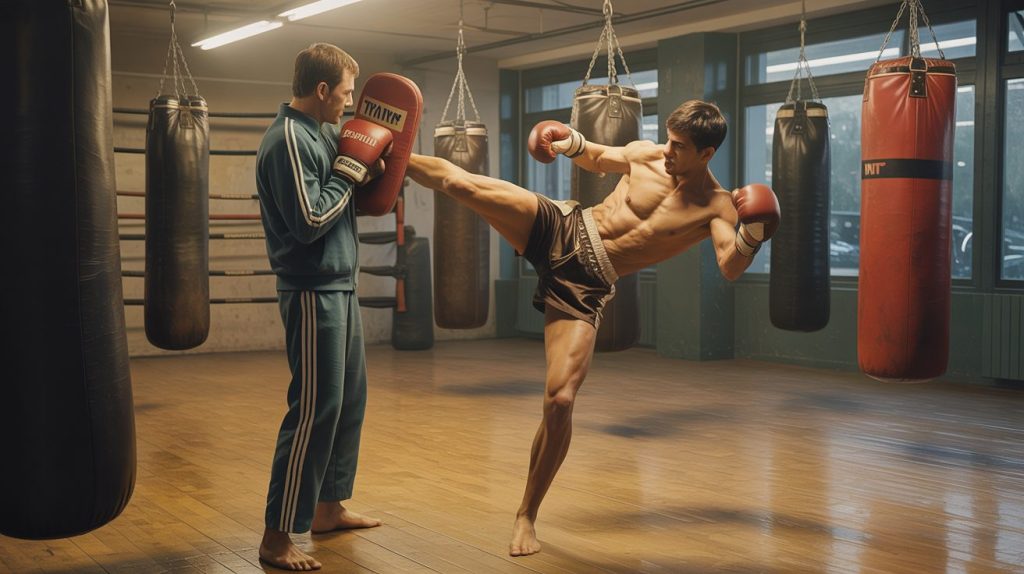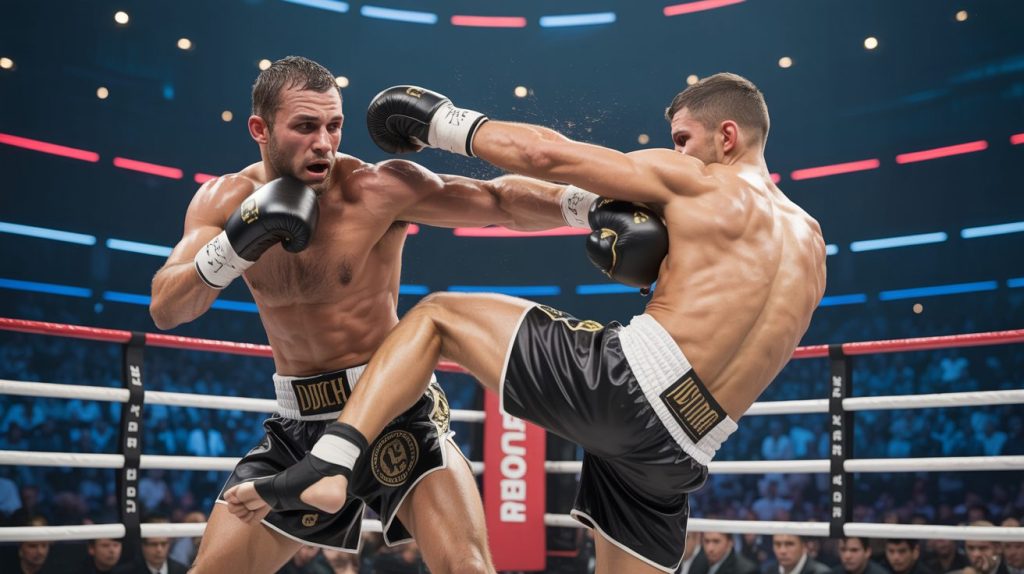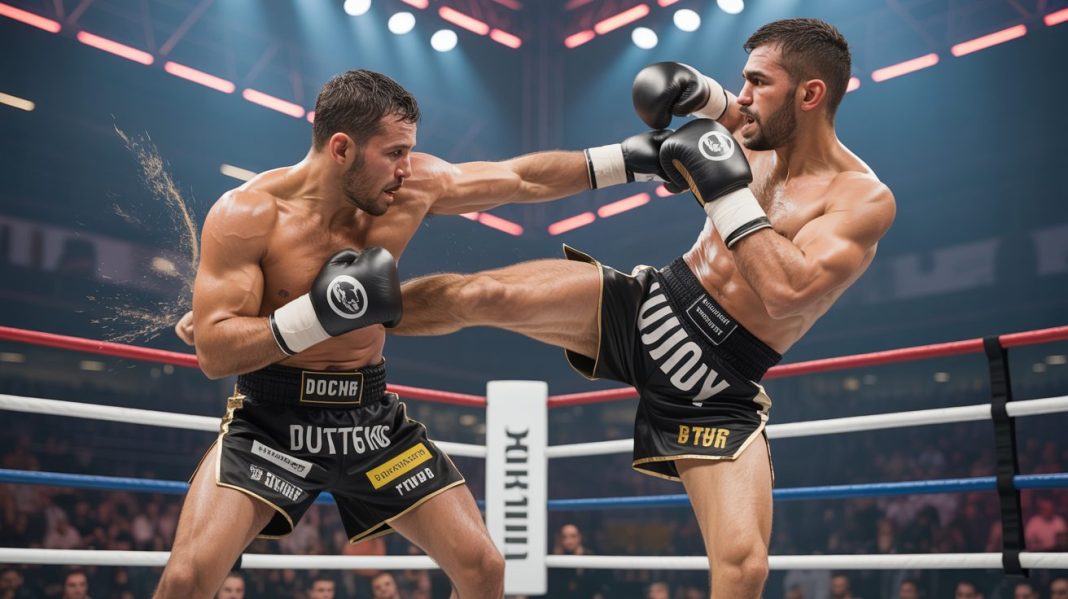Dutch kickboxing blends Kyokushin karate, Western boxing, and Muay Thai into a hard-hitting, pressure-based style famous for low kicks, relentless combos, and world-class champions. Learn its origins, training methods, top trainers, and why it’s so effective.
What Makes Dutch Kickboxing So Special?
Ask fighters and coaches around the world which striking styles they respect the most, and “Dutch kickboxing” comes up again and again.
It’s not just regular kickboxing with low kicks. Dutch kickboxing is a specific way of fighting and training that grew out of the Netherlands in the 1970s and 80s:
- Heavy boxing-style combinations
- Savage low kicks that chop down the legs
- Forward pressure and high pace
- Simple but brutal kick–punch–kick patterns drilled to automatic
It has powered generations of K-1, Glory, and MMA champions, and its influence shows up in striking gyms all over the world today.
Origins: From Japan to Amsterdam
Dutch kickboxing didn’t appear out of nowhere. It’s the product of Japanese karate and kickboxing, Western boxing, and Muay Thai all smashing together.
The Mejiro connection
In the 1960s–70s, Japanese fighter Kenji Kurosaki broke away from Kyokushin karate and began developing a more kickboxing-oriented style at his Mejiro Gym in Tokyo.
One of his key students was Jan Plas, a Dutch Kyokushin fighter who traveled to Japan, trained under Kurosaki, and brought that knowledge back to the Netherlands.
In 1978, Plas opened Mejiro Gym Amsterdam, which is widely considered the birthplace of Dutch kickboxing. There, the “Mejiro style” was refined: strong boxing, hard low kicks, and technical combinations that could win in both Japanese and European rulesets.
The Amsterdam fight factory: Mejiro, Chakuriki, Vos
Around the same time, other legendary gyms appeared:
- Chakuriki Gym – Founded by Thom Harinck in 1972. Chakuriki mixed boxing, karate, judo, and Muay Thai, producing tough, rugged fighters known for insane conditioning and mental toughness.
- Vos Gym – Another powerhouse Amsterdam gym, later associated with names like Ernesto Hoost and Ivan Hippolyte.
These three gyms developed a competitive rivalry that forced everyone to level up. They fought in Japan, in Thailand, and across Europe, proving that this Dutch hybrid style could hang with the best Muay Thai and kickboxing fighters in the world.
Key Characteristics of Dutch Kickboxing
So what actually defines “Dutch style” compared to Muay Thai or pure K-1 rules kickboxing?
1. Boxing first, kicks second (but the kicks hurt)
Dutch kickboxers are hands-heavy:
- Tight, technical boxing
- 3–5 punch combinations
- Low kicks slammed in at the end of combos
Instead of throwing a single kick and waiting, they punch their way in, low-kick you on exit, and keep marching forward.
2. Relentless forward pressure
Dutch fighters like to press and trap you:
- Small steps forward behind the jab and cross
- Constant combinations
- No long breaks, no dancing, just pressure
It’s often described as “controlled aggression” — not wild brawling, but a steady, grinding attack that forces you to defend instead of build your own offense.
3. Mid-range striking, limited clinch
Compared to Muay Thai:
- Less time in the clinch
- Fewer sweeps and dumps
- More time at mid-range, exchanging punches, low kicks, and occasional knees
Rulesets used in Europe and Japan also shaped this: clinching is often limited, so Dutch fighters developed a style that wins where they spend most of the fight — in front of you, in punching range.
4. Simple combos, endless drilling
Dutch kickboxing is not about fancy spinning stuff. It’s about:
- Jab–cross–hook–low kick
- Cross–hook–cross–body kick
- 1–2–low kick, 1–2–3–low kick
- Jab–cross–lead hook to body–rear kick
These patterns are drilled so much that fighters can throw them under pressure, when they’re tired, and when they’re getting hit back.
Legendary Dutch Trainers and Fighters
Dutch kickboxing became famous because of the coaches and champions it produced.
Founders and master coaches
- Jan Plas (Mejiro Gym) – Often called the father of Dutch kickboxing. Trained champions like Rob Kaman, Lucien Carbin, Andre Mannaart, Ernesto Hoost, and Peter Aerts.
- Thom Harinck (Chakuriki Gym) – Created the Chakuriki style and coached legends such as Peter Aerts and Branko Cikatić. Known for brutal conditioning and tough fighters.
- Cor Hemmers (Hemmers Gym) – Trained many world-class fighters, including Ramon Dekkers and other champions, and helped carry Dutch kickboxing into the K-1 and Glory era.
Other well-known Dutch coaches include Mike Passenier, Nicky Hemmers, Lucien Carbin, and many more who helped keep the style evolving for modern K-1 and MMA.
Iconic Dutch fighters
Some of the names that made the style famous:
- Rob Kaman – “Mr. Low Kick.” Nine-time world champion and one of the best examples of classic Dutch style.
- Ramon Dekkers – Dutch legend who became a superstar in Thailand by fighting top Thai champions with non-stop aggression.
- Peter Aerts, Ernesto Hoost, Remy Bonjasky, Alistair Overeem – K-1 legends who used Dutch combinations and low kicks to win world titles.
These fighters proved that Dutch kickboxing wasn’t just “European Muay Thai.” It was its own weapon.

How the Dutch Train: Hard Rounds, Hard Legs, Hard Conditioning
1. “Dutch drills” – give and take
One thing that stands out in Dutch gyms is their use of give-and-take partner drills:
- Fighter A throws a set combination
- Fighter B defends and immediately fires back their own combo
- Both stay in range the whole time
These are often called “Dutch drills” or “Holland drills.” They build timing, rhythm, and comfort in trading combinations at close range — exactly what you see in Dutch-style fights.
2. Heavy pad work and bag work
Sessions are full of:
- High-volume pad rounds – long combinations, low kicks, knees
- Hard heavy bag work – especially low kicks and body kicks
- Reps, reps, reps until technique holds up under fatigue
The focus is on practical combinations and fight pace, more than on isolated fancy techniques.
3. Sparring at realistic pace
Dutch gyms are known for intense sparring:
- Technical but hard
- Lots of exchanges
- Fighters learn to be comfortable when punches and kicks are flying both ways
This kind of sparring produces fighters who are mentally tough and used to pressure, which is why Dutch-style kickboxers often look so calm in the ring.
4. Conditioning from hell
Running, pad rounds, bag rounds, partner drills, sparring, and core work all stacked together create the classic Dutch engine:
- Strong legs
- High work rate
- Ability to keep throwing combinations deep into the fight
Modern gyms blend old-school Dutch conditioning with more advanced strength and conditioning, but the core idea is the same: your gas tank must support your pressure style.

Why Dutch Kickboxing Is So Effective
1. It fits modern kickboxing and MMA perfectly
Dutch kickboxing works great under K-1/Glory rules and crosses over well into MMA because:
- The boxing combinations translate perfectly to MMA striking
- Low kicks slow down wrestling and pressure fighters
- Simple patterns are easier to adapt when you add takedowns or clinch
That’s why many MMA fighters train “Dutch style” striking, even if they don’t call it that.
2. It builds real fight toughness
The style demands:
- Comfort under pressure
- Ability to take a shot and fire back
- Confidence in staying in the pocket and trading
The constant give-and-take drilling and sparring create fighters who don’t freeze, don’t panic, and don’t back up easily.
3. It’s simple, but not basic
On paper, a lot of Dutch combinations look simple:
- 1–2–low kick
- 1–2–3–low kick
- 2–3–2–body kick
But at a high level, the Dutch style uses:
- Timing
- Angle changes
- Setups and feints
- Rhythm shifts
It’s advanced simplicity — the same patterns used in smarter and smarter ways.
4. Huge benefits for students and hobbyists too
You don’t have to be a pro to get a lot out of Dutch kickboxing:
- Conditioning – great for fat loss and cardio
- Tough legs and hips from all the kicks
- Sharp hands from combination boxing
- Confidence from learning to stay calm under controlled pressure
For self-defense, the style doesn’t turn you into a ninja, but strong punches, good low kicks, and pressure-footwork are never a bad thing — especially when mixed with awareness and street-smart tactics.
Final Thoughts: Why People Call Dutch Kickboxing “One of the Best”
Dutch kickboxing became famous because:
- It blended Japanese karate/kickboxing, Muay Thai, and boxing into something new.
- It was pressure-based, simple, and brutally effective.
- It produced generations of champions who proved it on the world stage.
Whether you’re a fighter, a coach, or just a martial arts fan, Dutch kickboxing represents hard work, controlled aggression, and smart, battle-tested training. It’s not flashy—but it works.

